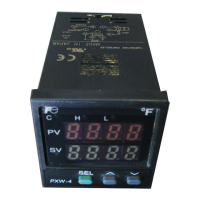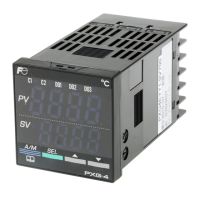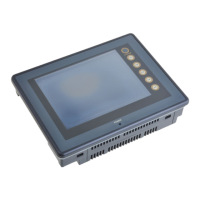17
P-dF Input Filter Constant: The Input Filter is used to filter
out the quick changes that occur to the process vari-
able in a dynamic or quick responding application
which causes erratic control. By slowing down the
response time, the PXW controller averages out the
peaks and valleys of a dynamic system which, in turn,
stabilizes the control. The digital filter also aids in con-
trolling processes where the electrical noise is affect-
ing the input signal. The larger the value entered, the
more filter added and the slower the controller reacts
to process variable changes. The smaller the value
entered, the less filter added and the quicker the con-
troller reacts to process variable changes. Enter as
small a value as possible that provides accurate and
stable control.
Setting range: 0.0-900.0 secs
P-An Alarm Hysteresis: The Alarm Hysteresis is that area on
one side of the alarm setpoint where the output does
not change condition. That area or deadband is intend-
ed to eliminate relay chatter at alarm setpoint with less
wear on the relay. With a wide Alarm Hysteresis, the
controller takes a longer time to change output condi-
tion. With a narrow Alarm Hysteresis, the controller
takes a short time to change output condition. Enter a
value which is just large enough to eliminate relay
chatter.
Setting Range: 0 to 50% of full scale, set in E.U.
FUZY Fuzzy Logic Control: Employing Fuzzy Logic Control in
addition to PID control eliminates system overshoot
and effectively suppresses fluctuation of the process
variable due to external disturbances. This function
may be enabled even during auto-tuning. Note that
fuzzy control is not effective in units with dual outputs,
due to the complexity of the process. Fuzzy control is
also inhibited while the Ramp/Soak function is in oper-
ation.
ADJ0 Input Calibration: This function is used for input cali-
bra-
ADJS tion by the user in a simple manner. Calibration is
effected by first applying the appropriate signal for
zero and span points of the input range being used
and then by correcting the errors. The user calibration
function is an independent function and the instrument
can easily be reset to conditions prior to delivery.
Example:
Input range 0-400°C
Indication at 0°C : -1°C
Indication at 400°C: 402°C
Change ADJ0 to 1 and ADJS to -2 to correct the error.
The instrument can be set back to factory values by
setting ADJ0 and ADJS to 0.
dSP1 Parameter Mask function: This function is used to indi-
to to vidually mask the display of parameters that are not
dSP7 used for your application, or parameters that are not
to be accessed by the operator. To mask or unmask a
parameter, appropriate values should be selected from
the DSP Assignment table.
Example 1:
To mask parameter P
1) Determine the dSP value for P from Quick Reference
P = dSP1 – 128
2) Add 128 to the existing dSP1 value.
Example 2:
To display/unmask the parameter P-F
1) Determine the dSP value for P-F from Quick
Reference
P-F = dSP4 – 2
2) Subtract 2 from the existing dSP4 value.
Table of Output Type Codes

